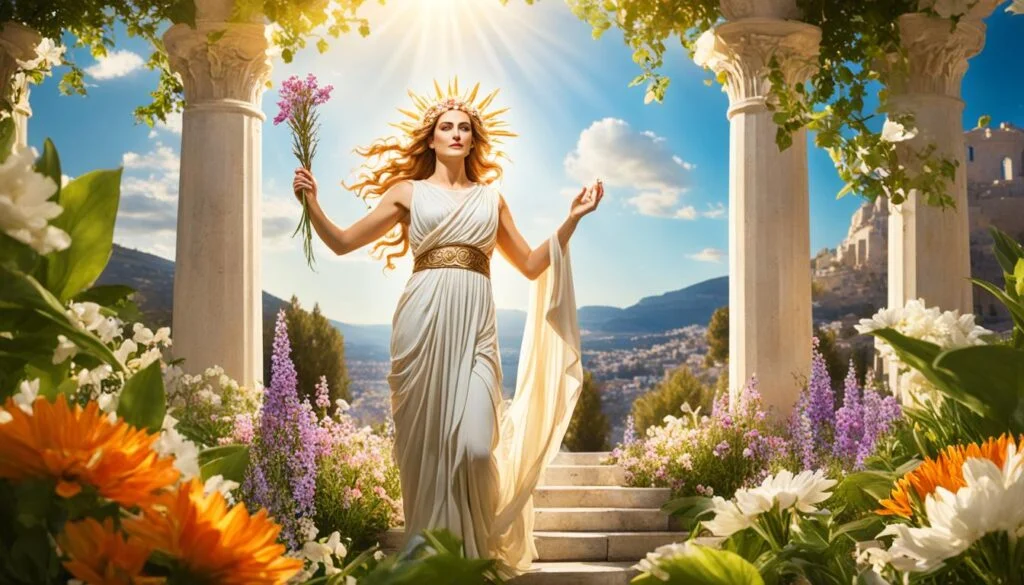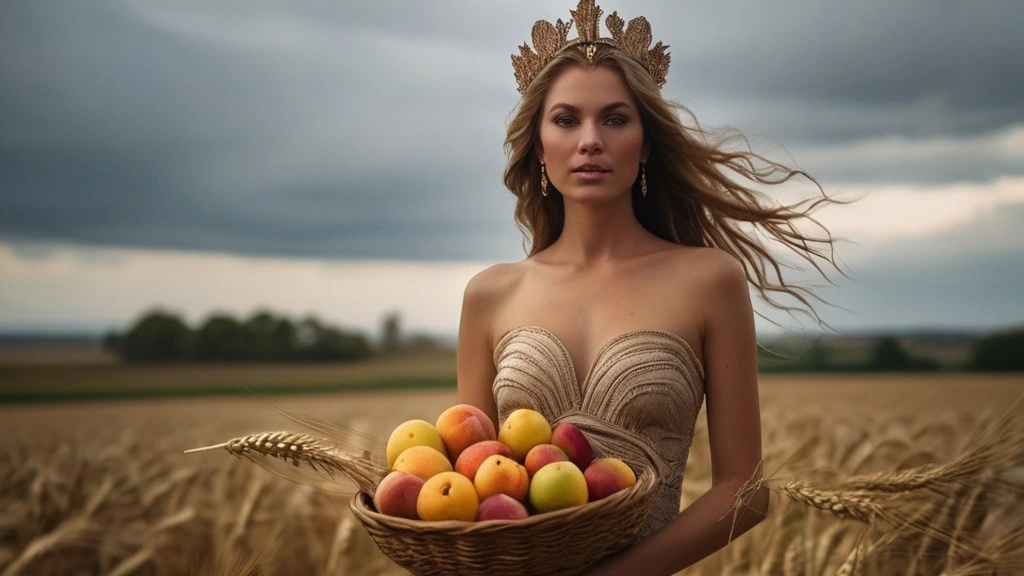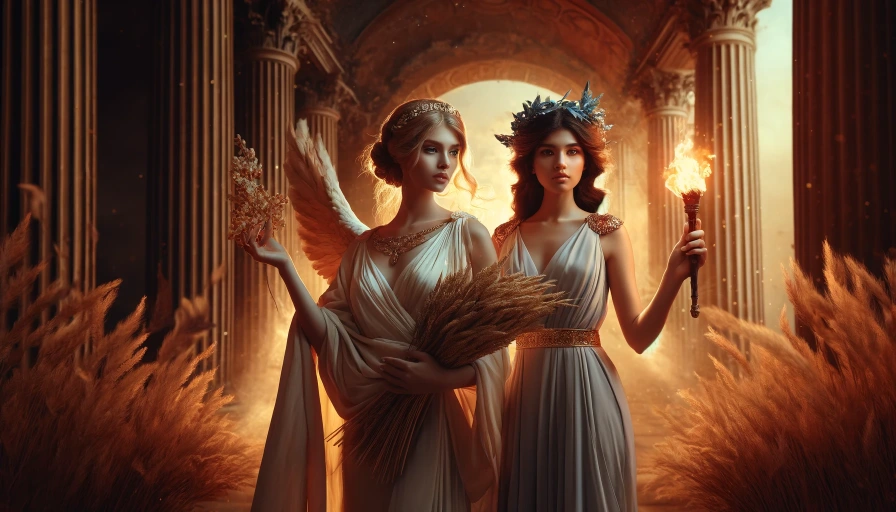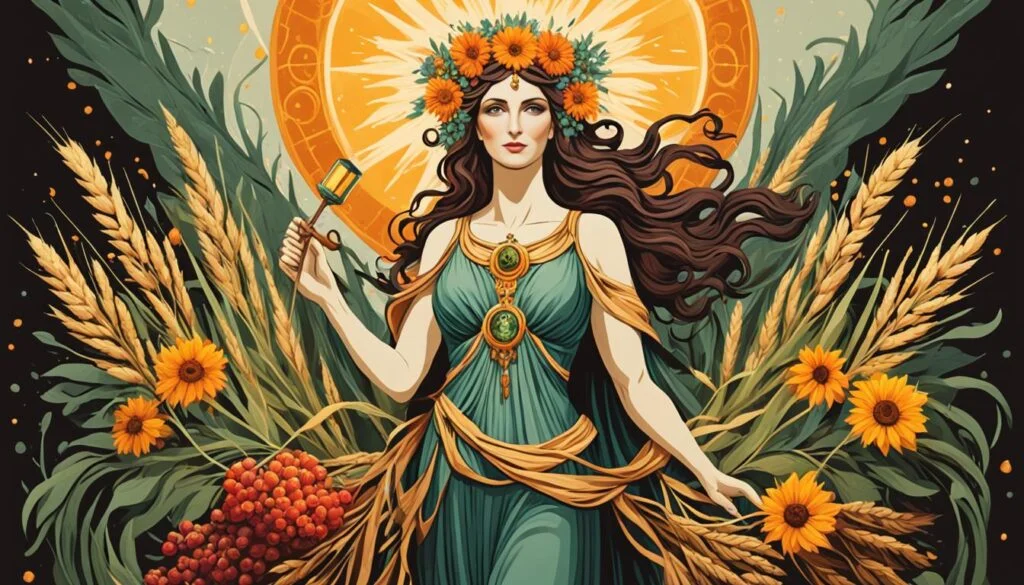In Greek mythology, Demeter is very special. She is like a green field in a dry place.
She is the Olympian goddess of the harvest, agriculture, fertility, and sacred law. Demeter’s work reaches far and wide. She is Persephone’s mom.
This ties her to our food and the changing seasons.
Demeter is a big part of ancient Greek life. If she stopped her godly work, bad things happened on Earth.
Like when Persephone was taken by Hades, Demeter’s sadness caused a terrible famine. This shows how important she is to life and death.
The Thesmophoria festival was a big event to honor her. It shows how deeply people respected her.
We start our story with Demeter, the goddess of harvest. We’ll see where she comes from, her special bond with Persephone, and how their story affects us.
Their myths have grown over time, just like plants ready for picking.
Key Takeaways:
- ✅ Understanding Demeter as a central figure of sustenance in Greek mythology and her connection to human survival.
- ✅ Exploring the divine mother-daughter bond between Demeter and Persephone and its significance in ancient religion and storytelling.
- ✅ Recognizing the historical and cultural significance of rites and festivals such as the Eleusinian Mysteries and Thesmophoria.
- ✅ Demeter’s entwined identity with deities across cultures, including the Anatolian goddess Cybele and the Roman goddess Ceres.
- ✅ Discovering the iconography of Demeter in ancient art, embodying the essence of the harvest with symbols of grain, flora, and the celestial zodiac.
Who Was Demeter in Greek Mythology?
Demeter holds a key place in Greek myths. She was the goddess of harvest, farming, and law.
Her role was vital for ancient people’s survival. We’ll explore Demeter, looking at her divine lineage, her importance in farming, and her special relationship with her daughter, Persephone.
The Divine Lineage of Demeter
Demeter came from the powerful Titans. She was Rhea and Cronus’s daughter, making her very special. She had famous brothers and sisters like Zeus.
Demeter’s Embrace: Agriculture and Fertility
Demeter is famous as the farming goddess. She is shown with things like the cornucopia and wheat.
She was called Sito and Thesmophoros, which showed her farming impact. Her temples were in beautiful groves. People offered sacrifices there to make the land fruitful.
Demeter and Persephone: An Enduring Bond
Demeter’s story isn’t complete without mentioning Persephone. Their bond explains the change of seasons.
Demeter had Persephone with Zeus. She also had other divine children. Through these stories, we see how Demeter cared for and protected life.
We’ve just seen how Demeter was a key goddess long ago. Her influence on farming and family was huge.
Her tales of rebirth, the value of the earth’s gifts, and family love are still told today.
The Mythical Origins of Demeter

Demeter’s story connects us deeply to the Earth. Her history is rich, coming from the Titans. This makes her a revered goddess in Greek myths.
She might not be as mentioned as other gods. But her influence is strong, felt in the soil that ancient people farmed.
Demeter’s Descent from the Titans
Demeter was the second child of Titans Rhea and Cronus. She brings a rich legacy from these ancient beings.
Her story is about life changes such as life, death, and rebirth. This is key to understanding her power. She is linked with her famous siblings in Greek myths.
The Greater Pantheon: Demeter’s Role Among the Olympians
- Guardian of the Harvest: Demeter cares deeply for the harvest. She stopped all growth when Persephone was taken. This shows how she is connected to farming and feeding people.
. - Divinity of the Underworld: As a chthonic deity, her worship was strong at events like Chthonia. Her role is vast, touching both the Earth’s renewal and underworld mysteries.
. - Agrarian Festivals: Festivals like Haloa, Thesmophoria, and Proerosia honored Demeter. They celebrate the cycle of sowing and harvesting she oversees.
. - Cult and Iconography: Demeter’s image was gentle, showing traits like Hera’s but softer. Her symbols—grain, baskets, pigs—were honored in Greek art and sculptures.
. - Sacred Law and Life Cycles: With titles like Sito and Thesmophoros, she was key to grains and sacred laws. She also symbolized the connection between life and death.
. - Eleusinian Mysteries: The Eleusinian Mysteries, held in her and Persephone’s honor, were secret rituals. These are still not fully understood today.
Demeter is essential in the Olympians for both the physical harvest and the spiritual food. She fed and nurtured the ancient people who adored her.
The Heartrending Story of Demeter and Her Daughter

We often find ourselves drawn to the heartrending story of Demeter and Persephone.
This ancient Greek myth grabs our interest. It also touches our hearts in stories told today.
Through this myth, we learn about the deep love between a mother and her daughter.
This has inspired many writers who were up for the 2021 Alex Award.
In the 20 honored books, we see many different ideas. From magical stories to new comics, writers use the myth in new ways.
Names like HarperCollins, Macmillan, Penguin Random House, and Tom Doherty Associates stand out.
They offer tales that remind us of the myth’s lessons on strength and tenderness.
- Rachel Smythe’s “Lore Olympus, Vol. 1” gives new life to our heartrending story, making it current and lively.
. - Ryka Aoki’s “Light From Uncommon Stars” shares a touching tale. It links a transgender runaway’s journey to our classical mother and daughter through music and feelings.
. - In “Malice” by Heather Walter, the theme of cursed destinies from Demeter and Persephone’s tale is transformed. It becomes a dark love story filled with challenges and growth.
The Alex Awards point out these stories matter to teens 12-18 years old. The winning books are celebrated for their truth and the strong bonds they show.
This mirrors the love Demeter had for Persephone.
- Genevieve Gornichec’s “The Witch’s Heart” brings a new voice to old tales, much like Demeter’s strong story.
. - “Winter’s Orbit” by Everina Maxwell takes us on a journey. It shows an arranged marriage in space, which reminds us of Demeter’s struggles.
. - “The 100 Years of Lennie and Margot” talks about the importance of friendship. It explores a core idea seen in Demeter and Persephone.
The 2022 Alex Awards show us these aren’t just stories. They help us understand feelings and relationships, like the Demeter and Persephone myth does.
These books invite us to find comfort, insight, and thoughtfulness. They do so just as the original heartrending story of love, loss, and coming back together has for years.
Understanding Demeter’s Powerful Symbols

In ancient Greece, every god had their own unique symbols and ways of worship. Demeter is special because she is linked with farming.
Her symbols and rituals and festivals show how important she was.
Looking into Demeter’s symbols, we find many important icons. A bundle of wheat stands for rich harvests, showing her power over grain.
Besides wheat, flowers symbolize growth and life. The torch shows her endless search for Persephone, revealing her deep love and pain.
Symbols and Their Significance in Worship
In holy places, symbols of Demeter were key for worship and connecting with her. Each sign had deep meanings, helping people in their rituals.
It helps us see how old cultures viewed gods, people, and nature.
Mystifying Rituals and Festivals
Ancient Greeks had many rituals and festivals for Demeter, marking the farming year.
The Haloa festival started in winter, celebrating planting time. During early spring, the Chloia festival was happy for the growing grains.
Before plowing, the Proerosia festival prayed for good harvests. At harvest time, the island of Cos had the Thalysia, a thank-you feast.
- The Thesmophoria, just for women, hoped to make the earth fertile again.
- The The Skirophoria, in midsummer, showed how deeply people worshiped and celebrated.
These festivities help us understand how mythology, farming, and community were all connected.
They show Demeter’s lasting impact as a symbol of food, growth, and the changing seasons.
The Sacred Cult of Demeter
The history of Greek mythology shows deep respect for Demeter’s sacred cult. She was a goddess loved far and wide.
Her sanctuaries were more than just places to worship. They stood as symbols of her vital role in devotees’ lives.
Consider places like Eleusis, Keleia, and Lerna. There, Demeter’s presence meant benevolence and power.
She was everywhere, from every grain of sand to the soil itself.
Agricultural festivals, like the Thesmophoria in Athens, honored Demeter. They offered the season’s first fruits to her.
This showed a special bond between mortals and the divine.
Her worship through these acts proved her as a key life and civilization sustainder. Athenians celebrated her rituals deeply.
These resonated in places like Sikyonia and Arkadia too. Each place had its own way to honor her, yet all were united in their devotion.
- Locations of Demeter Shrines: Ancient sites where her followers gathered to delve into the Mysteries.
- First Fruits Sacrifices: Festivals like the Thesmophoria, where offerings to Demeter held significant importance.
- Orgia or Mysteries: Ceremonial celebrations that underscored the sacred cult, strengthening the bond between the immortal and the mortal.
The sacred cult of Demeter was rich and complex. It was woven with the earth’s fertility and the cycles of life and death.
At its heart, her worship was about love, understanding life’s cycles, which she and Persephone beautifully showed.
Demeter’s Relationship with Persephone

The story of Demeter and Persephone in Greek mythology is touching. It shows deep love and separation.
This tale is not just a story. It reflects how the seasons change and how people feel about nature’s rhythms.
A Tale of Love and Separation
Demeter, the harvest goddess, has a close bond with her daughter, Persephone. She is shown with symbols like wheat and a torch.
These symbols stand for food and her never-ending search. With sacred animals around, Demeter shows the Earth’s life-loving traits.
But the story changes with Persephone’s abduction by Hades. This throws Demeter into deep sadness, a fear every parent knows.
Nature responds to her grief by becoming empty and withdrawn. This shows why seasons change from full to empty.
Persephone’s Abduction and the Earth’s Barren Response
When Persephone was taken by Hades, Earth became frozen under Demeter’s sorrow. No crops grew. Everything was lifeless.
But when Persephone came back, everything changed. Spring returned, showing a cycle of loss and renewal.
This theme is important in old festivals.
This story shows how the stars and people’s feelings are connected. It’s about Demeter’s sadness and happiness with Persephone’s return.
This bond was celebrated in big festivals. Their story of love and separation is more than a myth. It’s a deep cultural belief linking gods with our world.
We’ve explored Demeter’s relationship with Persephone. It’s a tale about love, loss, and the strong bond of family.
This ancient story still speaks to us. It shows cycles of life, death, and renewal that are key to our world understanding.
Demeter’s Progeny: A Look at Demeter’s Children
We now look at Demeter’s children in Greek mythology. She is the goddess of harvest and fertility. Her children play many roles in ancient stories.
Let’s discover the divine and mortal kids from Demeter’s big family.
Persephone: The Maiden of Spring and Queen of the Underworld
The most famous of Demeter’s children is Persephone. She is both the Maiden of Spring and the Underworld’s Queen.
This shows the cycle of life and death. It’s a key theme in Greek thought.
Persephone’s tale highlights the yearly seasons’ changes. It moves from bright fields to Hades’ dark realm and back.
Other Notable Offspring and Their Roles
Persephone isn’t Demeter’s only important child. Divine kids like Despoine and Areion have their own myths.
They’re often linked to special places and cults. They show the mix of human and nature’s mystic powers.
Plus, figures like Ploutos symbolize wealth and plenty. This comes from Demeter being with the mortal Iasion of Crete.
- Despoine and Areion: Poseidon and Demeter’s children, important in some local myths.
- Ploutos: The wealth god, born from Demeter’s human partner. It shows the boon of agriculture to people.
- Eubouleus: Tied to the Eleusinian Mysteries, showing Demeter’s part in life cycles and rebirth.
Demeter’s story is rich in Greek tales, mixing divine moments with human stories. Every child adds to her role.
She is a mother of people and civilizations. Through her, we get food and sacred stories.
The Eleusinian Mysteries: Initiation into Demeter’s Secrets
We explore the ancient Greek world to find the Eleusinian Mysteries. These are initiation rituals full of Demeter’s secrets.
They were important for over a thousand years in Greek and Roman culture.
The Mysteries had two parts: the ‘Lesser Mysteries’ in spring and the ‘Great Mysteries’ in fall. At first, only Greeks could join.
Later, Romans could too. This showed how many people wanted Demeter’s knowledge.
The journey began in Eleusis, led by Demeter’s priestess. They went to the Athenian agora. Everyone was cleaned in the sea.
Then they made sacrifices to Demeter. Pigs, linked to fertility, were often chosen.
- People enjoyed ceremonies with drinking, music, and dancing, like in old pottery.
- The nearby Thesmophoria festival was for women and Demeter. It helped with good crops.
- At the Eleusinia games, winners got grain. It showed how important Demeter was for food.
Talking about these Mysteries was forbidden and punished. But some, like Kalliope Papangeli, spent years studying them.
Eleusis went from sacred to industrial, like in Elefsina today. Companies like Titan Cement remember its glory.
The big ceremony used Kykeon, a strong drink. Many think it was magical. It ended the initiation.
Imagine walking thirty kilometers on the Hiera Hodos to Eleusis. There, people learned Demeter’s secrets. This made Eleusis very special, even today.
The Multifaceted Nature of Demeter’s Myths

In Greek mythology, Demeter is a symbol of nature’s cycles. Communities built sacred rites around her.
The multifaceted nature of Demeter’s myths shows us what ancient Greeks valued, especially in farming and earth’s gifts.
As a grain goddess, she stood for food and plenty. She was all about the wealth of the land.
We honor Demeter through many festivals. Each one shows a side of her divine care. Festivals like Haloa and Skirophoria praised her for giving life.
At Chthonia in Hermione, Argolis, a cow was sacrificed. This was a big honor. It showed Demeter was a powerful chthonic deity.
Demeter is also linked to the Great Mother, Cybele, and Gaea. They share a bond, rooted in the earth’s power to create life.
The term ‘Ioulo,’ meaning ‘grain sheaf,’ highlights Demeter as a revered grain mother. She is deeply respected in many ways.
Demeter is not just about crops. She is also about health, birth, and marriage. These roles show her connection to life and the underworld.
This duality shows how the Greeks saw life and death. Demeter’s presence reminded them of growth and decay.
Looking closer, we see Demeter represented with grain ears or a mystic basket. These show her as an agriculture goddess.
But her liking for pigs and being shown with a snake marks her as a chthonic deity. This adds depth to her worship.
Demeter as the Chthonic Deity
As a chthonic deity, Demeter symbolizes earth’s fertility. She governs life and death’s sacred cycle.
Often shown with a snake, it connects her to the underworld’s renewing powers. Her imagery is very telling.
Demeter’s Various Epithets and Their Meanings
- Thesmorphoros – She is the law-bringer, showing her role in setting sacred farming laws and nature’s cycles.
- Sito – This means she brings grain, showing her close relationship with the Greeks’ main food.
- Chloe – The green shoot, this shows how Demeter influences the renewal in spring.
These epithets show her many roles. They also call upon her different powers and kindness. Looking into these names, we find a wealth of stories and rituals.
In the ancient world, Demeter was as important as the earth itself.
Conclusion
Our journey into Greek mythology ends with Demeter’s story. She comes from a powerful family and became very important.
Her role is big not just because of her family, but because she helps the Earth. She makes the seasons change and helps crops grow.
Greek art shows her kindness to people, like giving Triptolemos the secret of farming.
Demeter’s story is famous for her adventures with her daughter, Persephone. This story shows how nature dies and comes back to life.
When Persephone is gone, Demeter makes it winter. When she returns, spring comes.
The Eleusinian Mysteries show the deep meaning of this story. They teach about life, death, and rebirth.
We end by remembering Demeter as the goddess of farming. She took care of the crops and was honored in many ceremonies.
She shows us how people and the Earth are closely linked. The story of Demeter and Persephone is still powerful today. It reminds us of the beautiful cycle of life.
Frequently Asked Questions
Q: Did Zeus and Demeter have a child?
Yes, Zeus and Demeter, both Olympian gods in Greek mythology, had a daughter named Persephone, who became the queen of the underworld after her abduction by Hades, with the consent of Zeus.
Q: What did Demeter do to Zeus?
Demeter didn’t directly do anything to Zeus, but she did rebel against him by ceasing the growth of all plants on earth when Persephone was taken to the underworld, which caused famine. This forced Zeus to negotiate Persephone’s return for part of the year.
Q: Is the Greek god Demeter a girl?
Yes, Demeter is a female deity in Greek mythology. She is known as the goddess of harvest and agriculture, among other things related to earth and fertility.
Q: Who was Demeter in love with?
Demeter had several love interests according to different myths. One of her notable consorts was Iasion, a mortal to whom she bore Plutus, the god of wealth. Her relationships typically reflect themes of fertility and the agricultural cycle.
Q: Why is Demeter so powerful?
Demeter is powerful because she controls the growth and productivity of crops as well as the seasons which are vital for human survival. She is one of the original six Olympians, and her powers affect both the earth’s natural processes and the life of mortals and immortals alike.
Q: What are 3 powers of Demeter?
Demeter’s primary powers include control over harvest and agriculture, ability to cause or prevent famine, and control over the seasons, specifically influencing the cycle of life and death in nature.
Q: Who is more powerful, Zeus or Demeter?
In Greek mythology, Zeus is considered more powerful overall because he is the king of the gods and rules over the sky and all gods. However, Demeter’s powers are crucial and unique to her domain, making her extremely powerful in her own right within her sphere of influence.
Q: Why did Demeter curse the earth?
Demeter cursed the earth to cease growing any plants and thus withhold her gifts from humanity as a form of protest to Zeus allowing Hades to take Persephone to the underworld, which plunged the world into famine until her daughter was allowed to return for part of the year.




